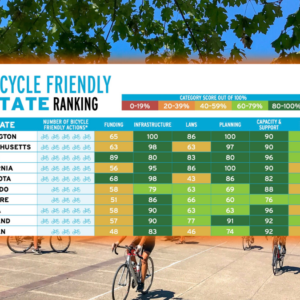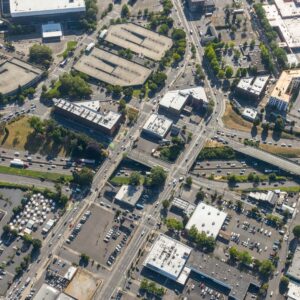“When we went back to figure out how the League got their low numbers, we discovered that they use a definition that is very narrow and doesn’t capture all funding.”
— Travis Brouwer, ODOT federal affairs
Oregon’s 8th place “Bike Friendly State” ranking by the League of American Bicyclists raised a lot of eyebrows around here. Oregon isn’t perfect; but 8th place? Behind Florida?!
In our coverage earlier this week we explored a few reasons these state rankings should be taken with a grain of salt (for instance, they don’t account for major things like our state-run Scenic Bikeways Program). And now, the Oregon Department of Transportation (ODOT) says the numbers used by the League gives even more reason to question the validity of the rankings.
According to the League, the key reason for Oregon’s low ranking was lackluster federal spending on bike-related projects (they gave us an “F” in the infrastructure category). However, according to ODOT Federal Affairs Advisor Travis Brouwer, the League undercalculated what ODOT spent on bikes in 2010 by about $16 million.
Numbers taken directly from ODOT’s Pedestrian and Bicycle Program Bi-Annual Report (PDF) shows that in 2010, Oregon’s allocation of state and federal funding for bicycling and walking infrastructure was $27,214,342. That, ODOT says is a record amount, more than double their annual average, and far more than the $11,457,224 the League’s analysis shows.
Here’s more from Brouwer (taken from email we obtained):
“When we went back to figure out how the League got their low numbers, we discovered that they use a definition that is very narrow and doesn’t capture all funding. For example, in the Transportation Enhancements Program, in 2010 Oregon obligated $6,339,569 for bicycle/pedestrian projects, but the League’s methodology captured just $2.7 million of this…
Among other flaws, the League’s method doesn’t capture any design costs, nor does it cover any bicycle/pedestrian elements associated with transit projects that are funded out of Surface Transportation Program or CMAQ [Congestion Mitigation Air Quality] funds. We also received very little credit for ARRA [federal stimulus] fund obligations for bicycle/pedestrian infrastructure — because we obligated virtually all of our ARRA funds in 2009.”
On that note about ARRA, statistics show that Oregon spent a larger percentage of ARRA funds on non-motorized projects, 16.7%, than all but three states.
It’s also worth noting, that of the 14 cities to have achieved either “Platinum” or “Gold” Bicycle Friendly City rankings by the League, three are from Oregon. That’s more than any other state except for California (which has four).
In the end, Brouwer’s concludes that the League’s Bike Friendly State rankings, “Should be taken with a grain of salt.”






Thanks for reading.
BikePortland has served this community with independent community journalism since 2005. We rely on subscriptions from readers like you to survive. Your financial support is vital in keeping this valuable resource alive and well.
Please subscribe today to strengthen and expand our work.
Shouldn’t fatality rankings figure into “bicycle friendliness”? FL is the most dangerous state to ride a bicycle by a binary order of magnitude over the runner-up, and a decimal order of magnitude over OR.
There’s pretty much no way Washington or California should have beat Oklahoma or Kansas based on having actually ridden in all four states…
I have to say this seems a little like sour grapes. I doubt very much Iifthe League’s criteria would have been called narrow if we had been ranked in the top few. In some ways it feels as if Oregon lawmakers are content with our current status and even a little bitter the cycling community would ask for better.
ODOT’s complaint only makes sense if they have reason to think that the flaws in the League’s methodology skew Oregon’s ranking *relative to other states*. In other words, they have to assume that the undercounting is somehow much worse in Oregon’s case than in other states. They didn’t, as far as I know, make this case, so perhaps they were, as you say, just whining.
The Oregon Bike Bill is 40 years old and ODOT already has bike/ped facilities on more than half of the state highways on which ODOT themselves says they are needed. At that pace, they will achieve 100% well before 2050.